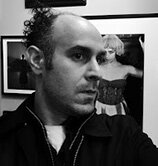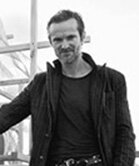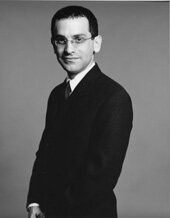Jurors
Reed Kroloff
In addition to his role as a principal in jones|kroloff, Reed Kroloff is the Director of the Cranbrook Academy of Art and Art Museum, and a nationally known commentator in the world of architecture and urban design.
Reed came to Cranbrook after serving as Dean of Architecture at Tulane University in New Orleans where he shepherded the school through the aftermath of Hurricane Katrina and co-chaired the commission charged with developing the initial master plan for rebuilding the city in the wake of the storm and subsequent flooding.
Prior to establishing jones|kroloff, Reed served as Editor-in-Chief of Architecture magazine. Under his direction, Architecture received more awards for editorial and design excellence than any magazine of its type, and quickly became the country’s leading design publication.
Eva Franch i Gilabert
 Franch is currently the Executive Director and Chief Curator of Storefront for Art and Architecture in New York City. She is a registered architect, researcher, curator and teacher, founder in 2003 of OOAA (office of architectural affairs). In the Fall of 2010 Franch became the 4th Director of Storefront for Art and Architecture after Joseph Grima, Sarah Herda and Shirin Neshat and Kyong Park.
Franch is currently the Executive Director and Chief Curator of Storefront for Art and Architecture in New York City. She is a registered architect, researcher, curator and teacher, founder in 2003 of OOAA (office of architectural affairs). In the Fall of 2010 Franch became the 4th Director of Storefront for Art and Architecture after Joseph Grima, Sarah Herda and Shirin Neshat and Kyong Park.
Prior to joining Storefront for Art and Architecture in 2010, Franch was an artist in residence at Schloss Solitude in Stuttgart and directed the Masters Thesis studio at Rice University. Previously she taught at SUNY Buffalo as the Peter Reyner Banham Fellow. She studied at TU Delft and earned a M. Arch from ETSAB-UPC, and an M. Arch. II from Princeton University. Her work has been exhibited in Europe, Asia and the United States including the Venice Biennale, and the Shenzen-Hong Kong Biennale. She has lectured nationally and internationally on art, architecture and design and the importance of alternative practices in the construction and understanding of public life.
Stephen Zacks
 Stephen Zacks is an internationally recognized architecture and urbanism reporter, theorist, and cultural producer based in Greenpoint, Brooklyn and a native of Flint, Michigan.
Stephen Zacks is an internationally recognized architecture and urbanism reporter, theorist, and cultural producer based in Greenpoint, Brooklyn and a native of Flint, Michigan.
He received an M.A. in Liberal Studies from the New School for Social Research, a B.A. in Interdisciplinary Humanities with Honors from Michigan State University, served as an editor at Metropolis, and has received awards from the NY State Council on the Arts, Newtown Creek Fund, Graham Foundation, ArtPlace, MacDowell Colony, and the Warhol Foundation. Founder and executive director of Flint Public Art Project and co-founder of the Bring to Light–Nuit Blanche New York festival, he is currently writing A Beautiful Ruin: The Generation that Transformed New York, 1967-1986, a nonfiction narrative about New York during the mid-70s fiscal crisis (Princeton Architectural Press, 2014).
Alois Kronschlaeger
 Alois Kronschlaeger’s work exists at the intersection of art, architecture, fashion and design. Kronschlaeger is best known for his site-specific installations and sculptures, which demonstrate a preoccupation with environment and light, as well as an interest in exploring time and space via geometry. Within the past two years, Kronschlaeger’s work has grown in scale from encompassing the entire horizontal plane of the Cristin Tierney Gallery in New York to encompassing the vertical axis of a 4-story abandoned building in Grand Rapids, Michigan. Most recently, he completed Habitat, a 27-part architectural intervention within the deserted habitat dioramas in the former Grand Rapids Public Museum. In 2013, Kronschlaeger will exhibit in Mexico City, Beijing, and he will have his first major solo exhibition at the Museum of Contemporary Art in Tucson, Arizona. Kronschlaeger is represented by Tierney Gardarin in New York
Alois Kronschlaeger’s work exists at the intersection of art, architecture, fashion and design. Kronschlaeger is best known for his site-specific installations and sculptures, which demonstrate a preoccupation with environment and light, as well as an interest in exploring time and space via geometry. Within the past two years, Kronschlaeger’s work has grown in scale from encompassing the entire horizontal plane of the Cristin Tierney Gallery in New York to encompassing the vertical axis of a 4-story abandoned building in Grand Rapids, Michigan. Most recently, he completed Habitat, a 27-part architectural intervention within the deserted habitat dioramas in the former Grand Rapids Public Museum. In 2013, Kronschlaeger will exhibit in Mexico City, Beijing, and he will have his first major solo exhibition at the Museum of Contemporary Art in Tucson, Arizona. Kronschlaeger is represented by Tierney Gardarin in New York
Process
Jurors will assess the submissions and determine winners. Jurors will base their judgment on their own expertise, the work submitted by the competitors, and the information contained on the competition website. Each juror will examine every submission.
Jurors who cannot attend each meeting of the jury may be replaced by an alternate selected by SiTE:LAB. Representatives of SiTE:LAB may observe jury meetings to ensure impartial enforcement of the competition’s regulations and intentions. If the jury deadlocks, Paul Amenta, SiTE:LAB curator, will cast the tie-breaking vote.
Selection Criteria
Selection criteria will include:
- Originality of the proposal’s design vision
- Responsiveness of the proposal to the competition’s objectives
- Responsiveness of the proposal to the site and its context
- Quality and clarity of presentation materials
- Responsiveness of the proposal to these instructions
Anonymity
The firms, partners, and professional associates of the jurors may not participate in the competition. If a juror is found to be knowingly involved in any material way with a submission, the juror will be replaced at the discretion of SiTE:LAB.
SiTE:LAB will protect the integrity of the jurying process. No entry will be accepted that contains any mark, logo or other indication of the identity of the competitor on the display surface. Only at the end of the jurying process will the identification of the competitor be revealed to the jury.

